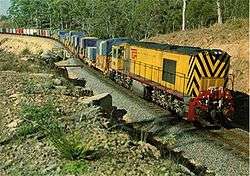Tasmanian Government Railways Za class
The Za class are a class of diesel locomotives built by English Electric Rocklea for the Tasmanian Government Railways in 1973.
| Tasmanian Government Railways Za class | |||||||||||||||||||||||||||||||||||||||||||||
|---|---|---|---|---|---|---|---|---|---|---|---|---|---|---|---|---|---|---|---|---|---|---|---|---|---|---|---|---|---|---|---|---|---|---|---|---|---|---|---|---|---|---|---|---|---|
 ZA class locomotive at Bell Bay in February 1978 | |||||||||||||||||||||||||||||||||||||||||||||
| |||||||||||||||||||||||||||||||||||||||||||||
| |||||||||||||||||||||||||||||||||||||||||||||
| |||||||||||||||||||||||||||||||||||||||||||||
| |||||||||||||||||||||||||||||||||||||||||||||
History
With the construction of a new line from Launceston to Bell Bay, Tasmanian Government Railways placed an order for four 1752 kW locomotives with English Electric. A further two were delivered in 1976, ZA 6 being the final locomotive built by GEC Australia [1][2] and the last English Electric locomotive built anywhere.
In March 1978 the Za class were included in the transfer of the Tasmanian Government Railways to Australian National. From 1982 all had their vacuum brakes replaced with air brakes.[3]
In June 1998 the five in service were renumbered as the 2114 class, ZA4 having been withdrawn.[4]
In May 2014, 2114 joined 2115 and 2118 in storage after the new TR class entered full service. 2114 (ZA1) was listed for sale and is likely to be scrapped while 2118 (ZA6) is held for preservation with 2115 (ZA2) retained as a parts donor.
Status table
| Original no | Last no | Owner | Status |
|---|---|---|---|
| Za1 | 2114 | TasRail | Stored |
| Za2 | 2115 | TasRail | Stored |
| Za3 | 2116 | TasRail | Scrapped |
| Za4 | Za4 | AN Tasrail | Scrapped |
| Za5 | 2117 | TasRail | Scrapped |
| Za6 | 2118 | TasRail | Stored |